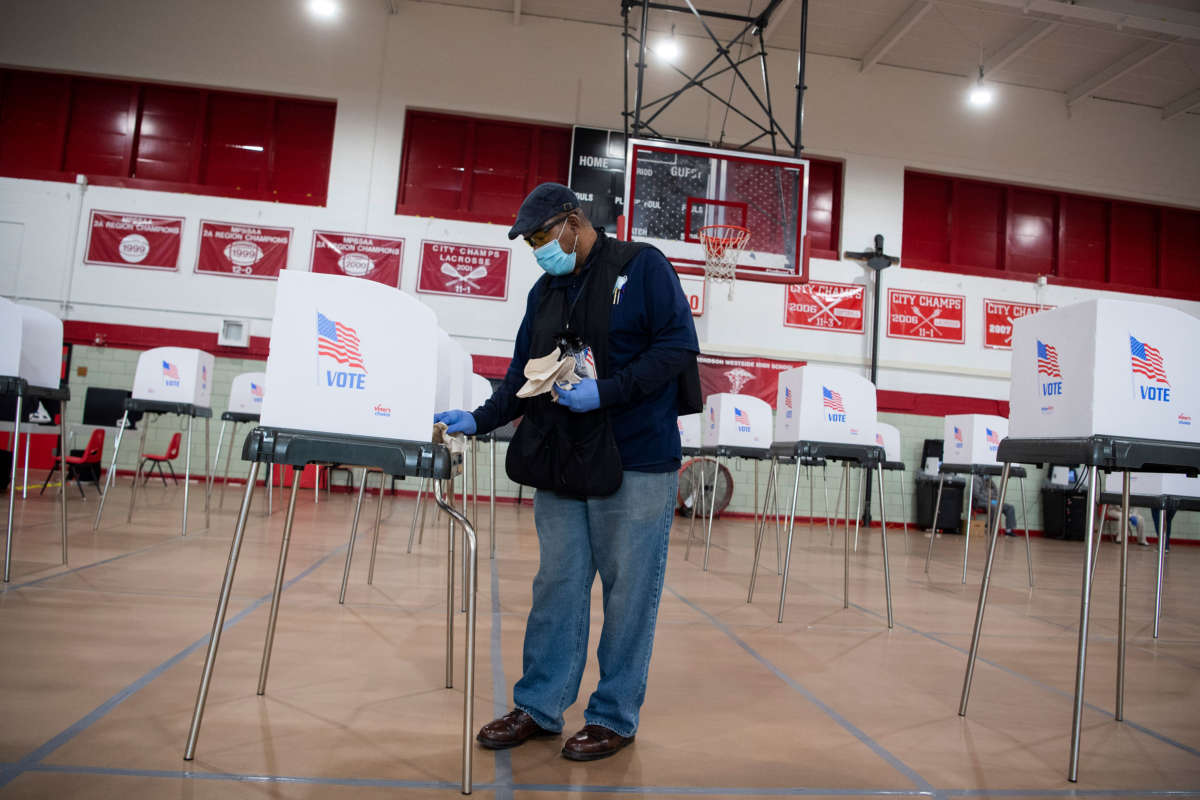Part of the Series
Voting Wrongs
As the COVID-19 pandemic spirals out of control, it’s become clear that our traditional Election Day practices aren’t suited for a pandemic. In response, some states have already begun to postpone primary elections. But elections — the foundation of our democracy — must be held, and we must make legal and policy changes now to ensure a safe, accessible and trustworthy election in November.
It may be impossible to develop a perfect solution. Purely from an infectious disease control standpoint, the best practice is for everyone to complete their ballots at home, and then submit them by mail or, perhaps, at some type of drive-through or walk-through drop-off center. All voters — whether they are at home, in the hospital, in a homeless shelter, or anywhere else — should be able to request and complete mail-in ballots as easily as possible.
Sixteen states still impose rules requiring a specific, documented excuse from a list of approved reasons to vote by mail. We must make voting by mail available, and easy, throughout the nation — and expand local and state capacity to receive and safely handle mail-in ballots. The federal stimulus package provides some limited funding for this, but not enough; a bill proposed by Senators Amy Klobuchar and Ron Wyden would substantially help, as it would require all states to offer no-excuse vote-by-mail, establish procedures and requirements for security and access, and provide funding to reimburse states for the costs.
But an election without polling places would sacrifice important democratic values: equity and human rights. Studies show that younger voters and voters of color are significantly more likely to vote in person than by mail, and their mail-in ballots are much more likely to be rejected. Finally, many voters — including people without stable homes, people who need language assistance, and people with disabilities — can’t reliably receive and complete a ballot anywhere besides a polling place.
To make in-person voting safe, start with social distancing. We must spread people out as much as possible, across time and space, so voters aren’t stuck in long lines or crowded spaces. Expanding early voting will spread out the flow of people. The number of polling sites must also be greatly expanded in every state. Similarly, the voting process should be made as fast as possible. Any procedure or barrier that slows down the voting process will cause a buildup of long lines, a potential health hazard.
That means we’ll need more than the usual number of poll workers — especially because some may need to call in sick on Election Day. Training for new workers should be done immediately and remotely. There’s a large pool of unemployed workers who could be paid for this labor in the short term. (Poll workers who are at greater risk, such as senior citizens, could work in lower-risk parts of the process, such as processing mail-in ballots.) And all poll workers should receive personal protective equipment, such as masks, for use during their shifts.
Furthermore, election officials should work with state and local health departments to develop no-common-touch voting methods. People should not be repeatedly touching the same surfaces without disinfection because the virus that causes COVID-19 can survive for several days on surfaces.
The safest in-person voting method, for any voter who can use a pen, is to hand-mark a paper ballot. Each paper ballot is usually only handled by one poll worker before it is given to the voter. In many cases, ballots could be given to voters outside the polling place, and voters could mark them with a disposable pen on a disposable writing surface. Voting booths, if they must be used at all, should be disinfected according to Centers for Disease Control and Prevention guidelines, ideally after every voter.
Unfortunately, electronic voting machines, which are touched by hundreds or thousands of people, are much harder to disinfect between voters. Common disinfectants can damage machine components. Vendors and the U.S. Election Assistance Commission warn that poll workers attempting to clean voting machines might “alter the sensitivity” of touch screens or “inadvertently activate buttons while wiping.”
To prevent the voting equipment from becoming a disease vector, all states should move immediately to hand-marked paper ballots, while retaining at least one accessible voting machine per polling place for voters with disabilities as required by federal law. This should also speed up the voting process. Since paper ballots and pens are cheap, but electronic voting machines are expensive, most polling sites can handle more people simultaneously voting on paper (while still maintaining safe distances) than by machine. That means shorter lines.
Finally, officials must relocate community polling sites out of senior centers or residential facilities, taking into account both the need to protect vulnerable populations from the virus and the need to ensure accessibility by those very populations.
We can hold a free and fair election this November (as we did during the 1918 flu), and we must do so. In the midst of a pandemic, we must have a president, governors and mayors who have the consent of the governed. That requires a free, fair and safe election.
Join us in defending the truth before it’s too late
The future of independent journalism is uncertain, and the consequences of losing it are too grave to ignore. To ensure Truthout remains safe, strong, and free, we need to raise $24,000 by the end of today. Every dollar raised goes directly toward the costs of producing news you can trust.
Please give what you can — because by supporting us with a tax-deductible donation, you’re not just preserving a source of news, you’re helping to safeguard what’s left of our democracy.
